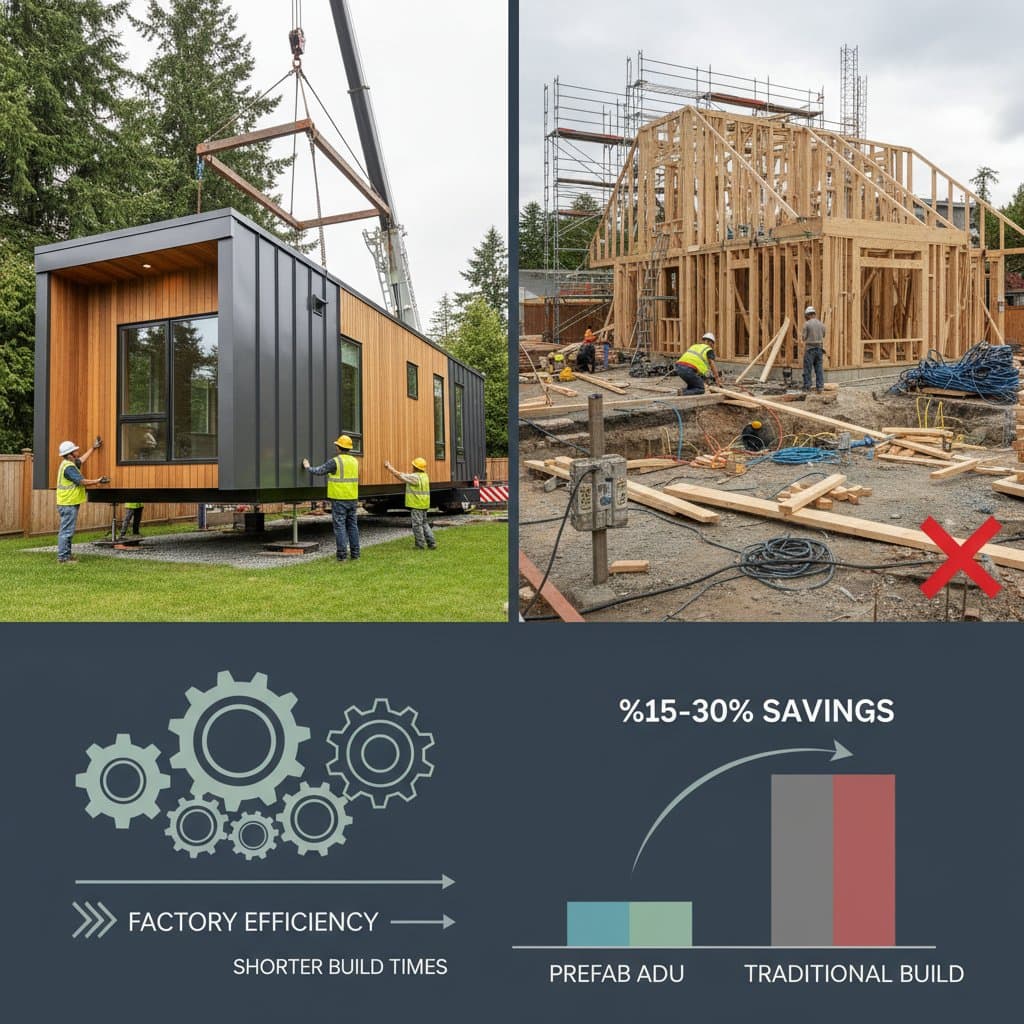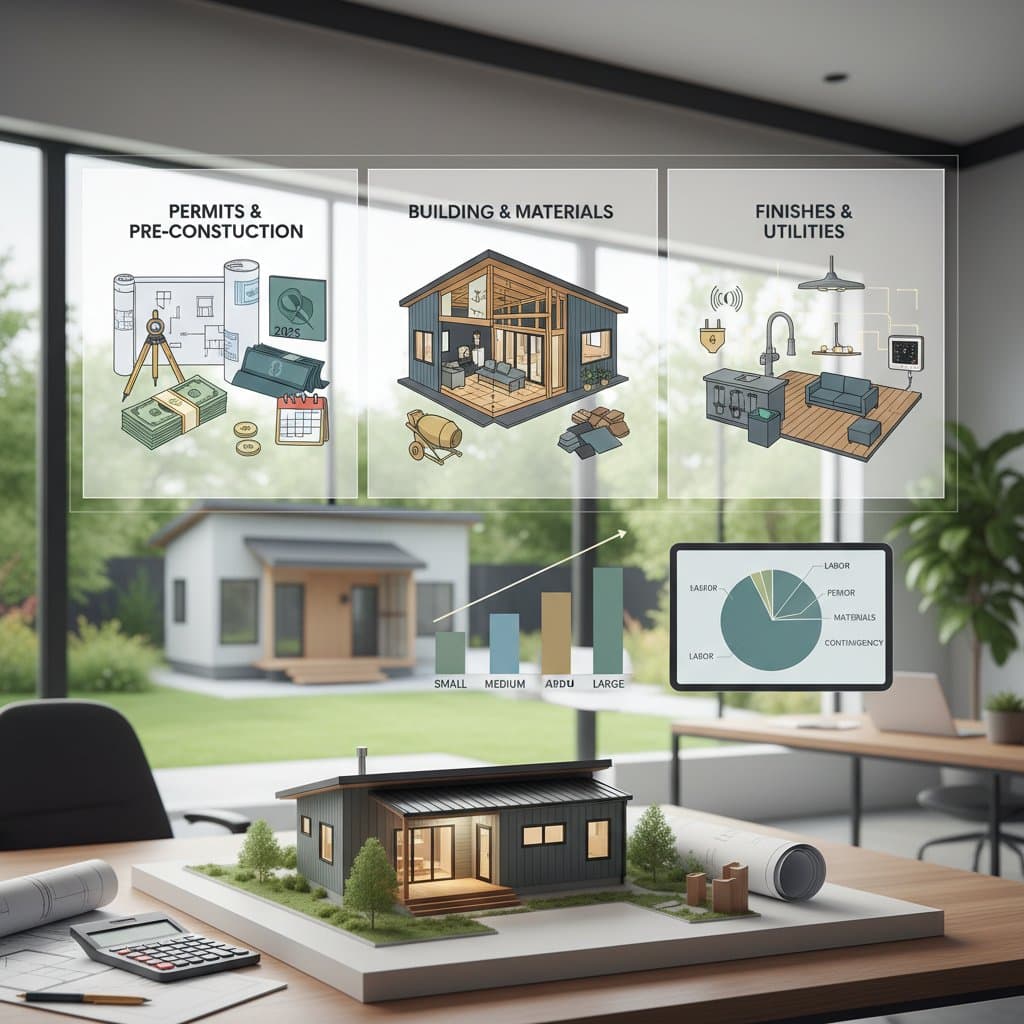The Real Costs of Building an ADU in 2025
Accessory Dwelling Units, known as ADUs, serve as a practical option for homeowners seeking additional living space, rental revenue, or adaptable areas like home offices. With escalating housing prices and shifting zoning laws, an ADU enhances property worth and supports enduring financial security. However, grasping the actual expenses involved proves crucial prior to initiating the project.
This guide delineates factors affecting ADU construction expenses, effective budgeting methods, and scenarios for engaging professionals. It addresses design selections, regional influences, and investment returns to empower informed choices from the outset.
Understanding the Types of ADUs
Prior to cost estimation, familiarize yourself with primary ADU categories and their variations in complexity and price.
Detached ADU or Backyard Cottage
A detached unit exists independently from the primary residence, providing complete seclusion and versatility for visitors or tenants. Such structures frequently mimic compact cottages or minimalist homes.
- Typical cost range: $250 to $500 per square foot
- Best for: Enhancing privacy and establishing a dedicated rental asset
- Challenges: Necessitates a fresh foundation, comprehensive utilities, and distinct permits
Attached ADU
An attached ADU connects via one shared wall with the main dwelling. Construction may involve an extension or adaptation of a garage space.
- Typical cost range: $200 to $400 per square foot
- Best for: Households aiming to accommodate extended family members
- Challenges: Demands seamless structural merging with the current structure
Basement Conversion
Transforming an incomplete or idle basement into habitable quarters often represents the most economical selection.
- Typical cost range: $150 to $300 per square foot
- Best for: Properties equipped with pre-existing plumbing and sufficient ceiling clearance
- Challenges: Involves managing moisture, installing egress windows, and improving ventilation
Garage Conversion
Adapting a standalone or connected garage proves efficient when the framework remains sturdy.
- Typical cost range: $120 to $250 per square foot
- Best for: Property owners pursuing a modest, expedited ADU
- Challenges: Encompasses insulation enhancements, foundation adjustments, and reinforcement measures
What Drives ADU Construction Costs
Each ADU endeavor encompasses multiple expense tiers. Identifying these elements enables realistic planning and prevents unforeseen financial strains.
1. Site Conditions
Irregular landscapes, substandard soil, or restricted lot entry can elevate excavation and foundation expenditures by 10 to 25 percent. Properties featuring established trees, confined driveways, or pre-installed utility conduits require extra labor and site grading efforts.
2. Size and Layout
Larger dimensions correlate with elevated overall expenses. Compact ADUs below 500 square feet incur higher per-square-foot rates since they demand identical systems and completions as expansive counterparts.
3. Utility Connections
Linking water, sewage, and electricity spans $5,000 to $30,000, contingent on proximity to the primary home and municipal infrastructure. Upgrading electrical panels or plumbing conduits incurs additional charges yet ensures adherence to safety standards and regulations.
4. Permits and Fees
Municipal charges fluctuate significantly. Anticipate $5,000 to $20,000 for planning, permitting, and impact assessments. Certain regions provide reductions or incentives for compact units; verify local ordinances promptly.
5. Materials and Finishes
Luxury finishes, intricate tile installations, and energy-conserving windows accelerate expenses. Opting for moderate materials that harmonize aesthetics and resilience trims costs while preserving attractiveness.
6. Labor and Professional Services
Labor constitutes 40 to 60 percent of the aggregate expense. Employing certified experts guarantees regulatory compliance and averts costly rectifications subsequently. Architects, engineers, and surveyors contribute another 10 to 15 percent to the budget.
Average ADU Cost Ranges by Construction Type
| ADU Type | Average Cost per Square Foot | Total Estimated Range (400–800 sq ft) |
|---|---|---|
| Detached ADU | $250–$500 | $100,000–$400,000 |
| Attached ADU | $200–$400 | $80,000–$320,000 |
| Garage Conversion | $120–$250 | $50,000–$200,000 |
| Basement Conversion | $150–$300 | $60,000–$240,000 |
These figures incorporate materials, labor, and fundamental finishes, excluding furnishings, landscaping, or permit charges. Incorporating upscale kitchens, solar installations, or elaborate roof designs can inflate totals further.
DIY vs Professional Construction
When DIY Works
A homeowner possessing building expertise might manage minor aspects, including painting, flooring installation, or basic landscaping. Such participation yields 5 to 10 percent savings when executed securely and in line with codes.
When to Hire a Professional
Structural modifications, plumbing, electrical systems, and roofing mandate certified specialists. Experts verify code conformity, appropriate permitting, and reliable durability. Intricate designs or engineering demands require qualified supervision without exception.
Balancing Time and Cost
DIY efforts frequently extend schedules, thereby raising holding expenses and postponing rental revenues. Weigh potential economies against timeline extensions prior to determining involvement levels.
Permitting, Site Prep, and Utilities
Permitting and Design Review
Local planning offices typically mandate site diagrams, floor layouts, and elevation sketches. Examination fees, impact evaluations, and plan verifications may aggregate several thousand dollars. Furnishing thorough, precise submissions minimizes postponements.
Site Preparation
Removing foliage, leveling terrain, and establishing a foundation generally costs $10,000 to $25,000. Sloped sites or drainage concerns necessitate supplementary allocations for retaining structures or runoff solutions.
Utility Hookups
Integrating novel plumbing and electrical frameworks ranks among overlooked outlays. When primary sewer lines reside deeply or remotely from the ADU, excavation reaches $200 per linear foot. Solicit utility evaluations before design finalization.
Design, Materials, and Customization
Choosing the Right Materials
Resilience and upkeep considerations direct material choices. Fiber-cement exteriors, metal coverings, and vinyl frames excel across diverse weather conditions. Steer clear of inexpensive options prone to recurrent upkeep or refinishing.
Interior Finishes
Cupboards, surfaces, and illumination affect both expenditure and market appeal. For rental spaces experiencing heavy use, select wear-resistant choices like luxury vinyl plank floors and quartz surfaces.
Energy Efficiency
Superior insulation, LED illumination, and water-conserving fixtures diminish ongoing utility bills by up to 30 percent. Incorporating solar arrays or heat pumps elevates initial outlays yet boosts asset value and ecological benefits.
Style and Compatibility
Align the ADU facade with the principal residence to sustain visual harmony. Uniform roof profiles, accent hues, and substances render the extension cohesive rather than ancillary.
ROI and Long-Term Financial Value
ADUs deliver robust yields via leasing proceeds and elevated property assessments. Residences featuring compliant ADUs typically gain 20 to 35 percent more appreciation than similar units lacking them. Yearly leasing revenue varies from $15,000 to $40,000 according to locale and dimensions.
For owners uninterested in rentals, an ADU functions as a visitor accommodation, professional workspace, or prospective caregiver quarters. These versatile applications confer monetary and practical advantages.
Cost Recovery Timeline
Property owners generally recoup building expenses in 8 to 15 years via leasing or sale profits. Economical adaptations reimburse quicker, whereas novel detached constructions extend due to substantial upfront commitments.
Money-Saving Strategies
- Simplify the design. Employ straightforward roof angles and boxy configurations to curtail framing and roofing outlays.
- Use prefabricated or modular units. Pre-assembled ADUs from factories cut labor expenses by 15 to 25 percent.
- Repurpose existing spaces. Adapting garages or basements circumvents foundation and utility investments.
- Plan for shared utilities. Leveraging current connections spares thousands in excavation and approvals.
- Choose mid-range finishes. Sturdy, low-maintenance selections control budgets without diminishing quality.
- Get multiple bids. Soliciting proposals from at least three certified builders secures equitable rates and standards.
When to Hire a Professional
Structural or Complex Systems
Engage a certified general contractor for initiatives involving novel foundations, framing, or roofing. These components demand safety checks, load computations, and familiarity with regional codes.
Electrical and Plumbing
Licensed electricians and plumbers alone handle these operations. Errors invite regulatory breaches or risks that prove costlier to remedy afterward.
Design and Engineering
Architects and structural engineers confirm proper integration with the existing property and zoning adherence. Their knowledge averts subsequent approval denials or stability concerns.
Selecting the Right Contractor
Request referrals, credentials, and insurance verification. Examine comparable recent ADU undertakings. Detailed agreements outlining expenses safeguard interests and align projections.
Common Questions
How long does it take to build an ADU?
Most initiatives span six to twelve months from conception to finish, influenced by approval durations and build intricacy.
Can an ADU have a separate mailing address or utilities?
Affirmative; numerous municipalities permit distinct addresses and metering, subject to zoning and provider guidelines.
Do ADUs require separate parking spaces?
Certain zones exempt parking mandates for ADUs proximate to transit or on compact parcels. Consult local codes pre-design.
What size ADU can I build?
Standard caps span 400 to 1,200 square feet, with precise limits dictated by lot dimensions and coverage rules.
Steps to Launch Your ADU Project
To proceed, commence by assessing your property's zoning eligibility and consulting local planners for incentives. Assemble a team of vetted professionals early to refine designs and secure bids. Track all expenses meticulously against your budget to realize the full potential of this value-adding endeavor.








